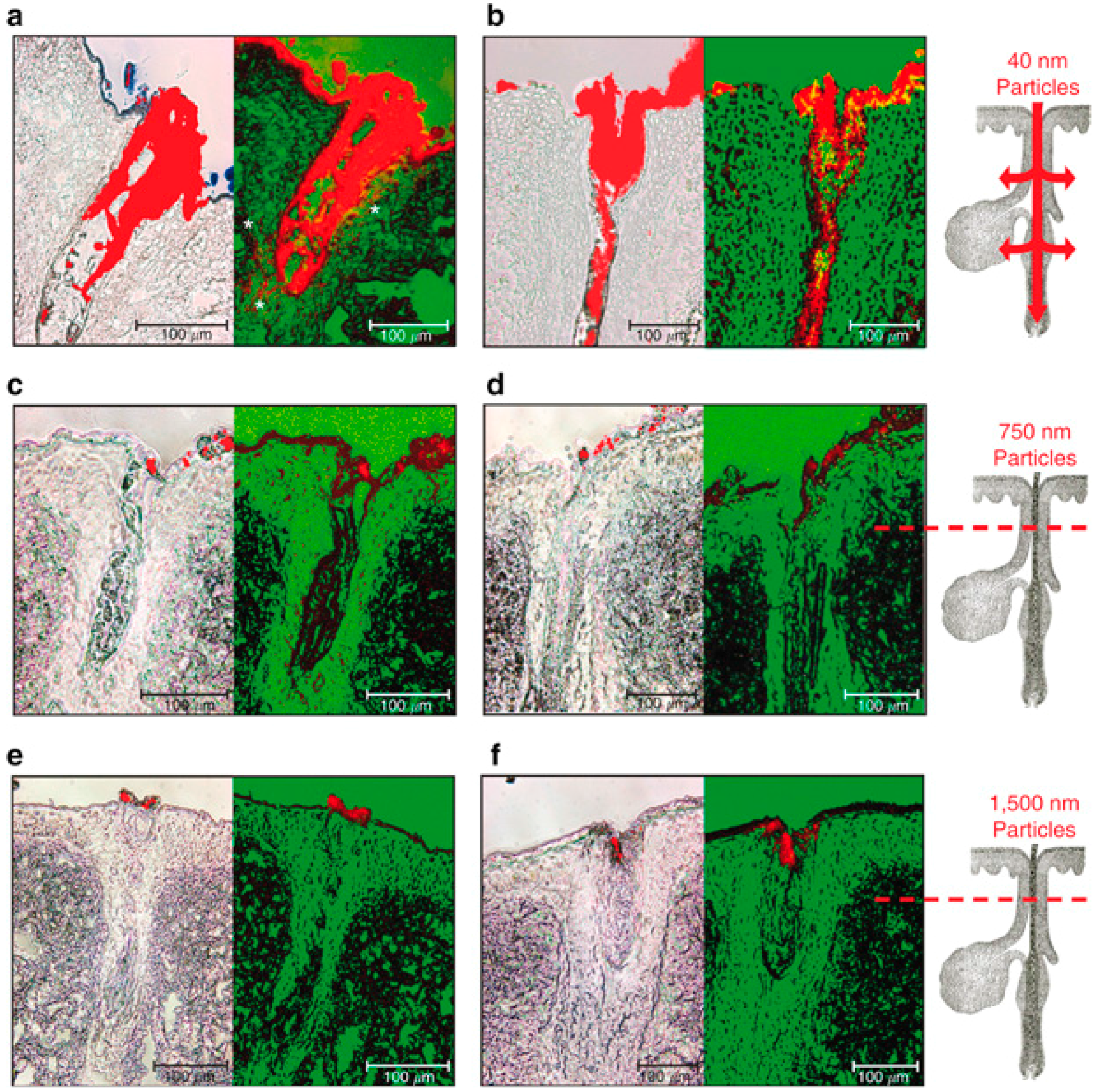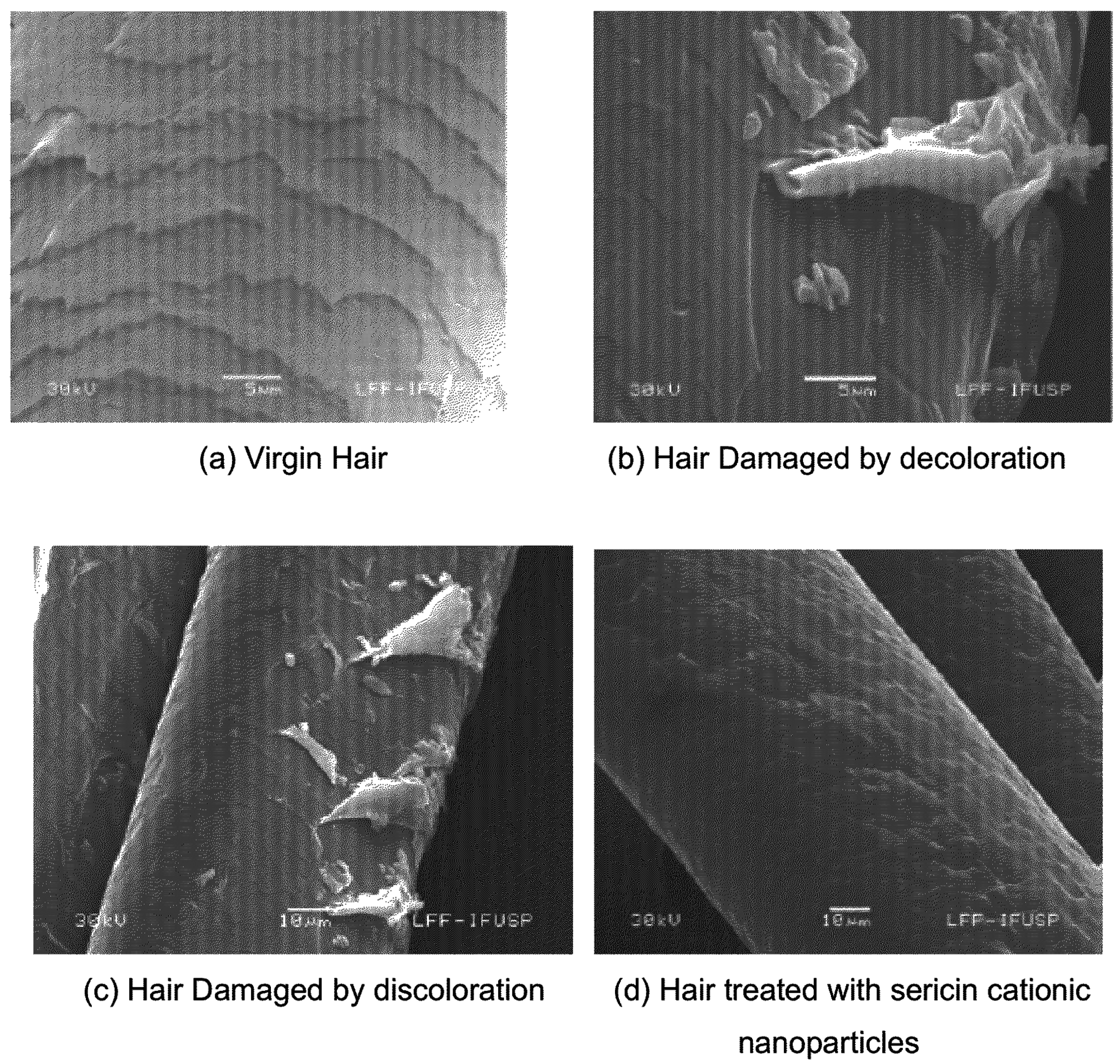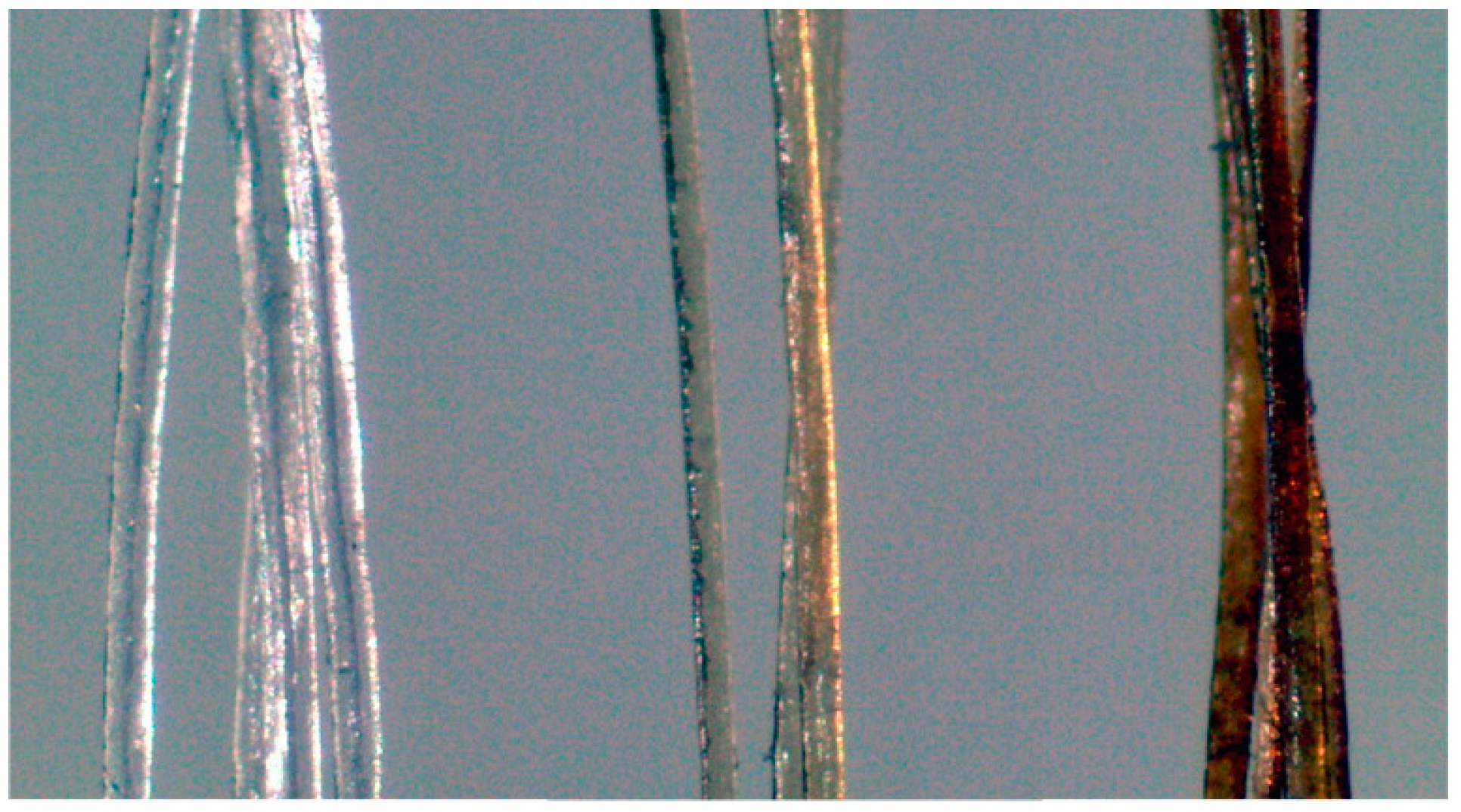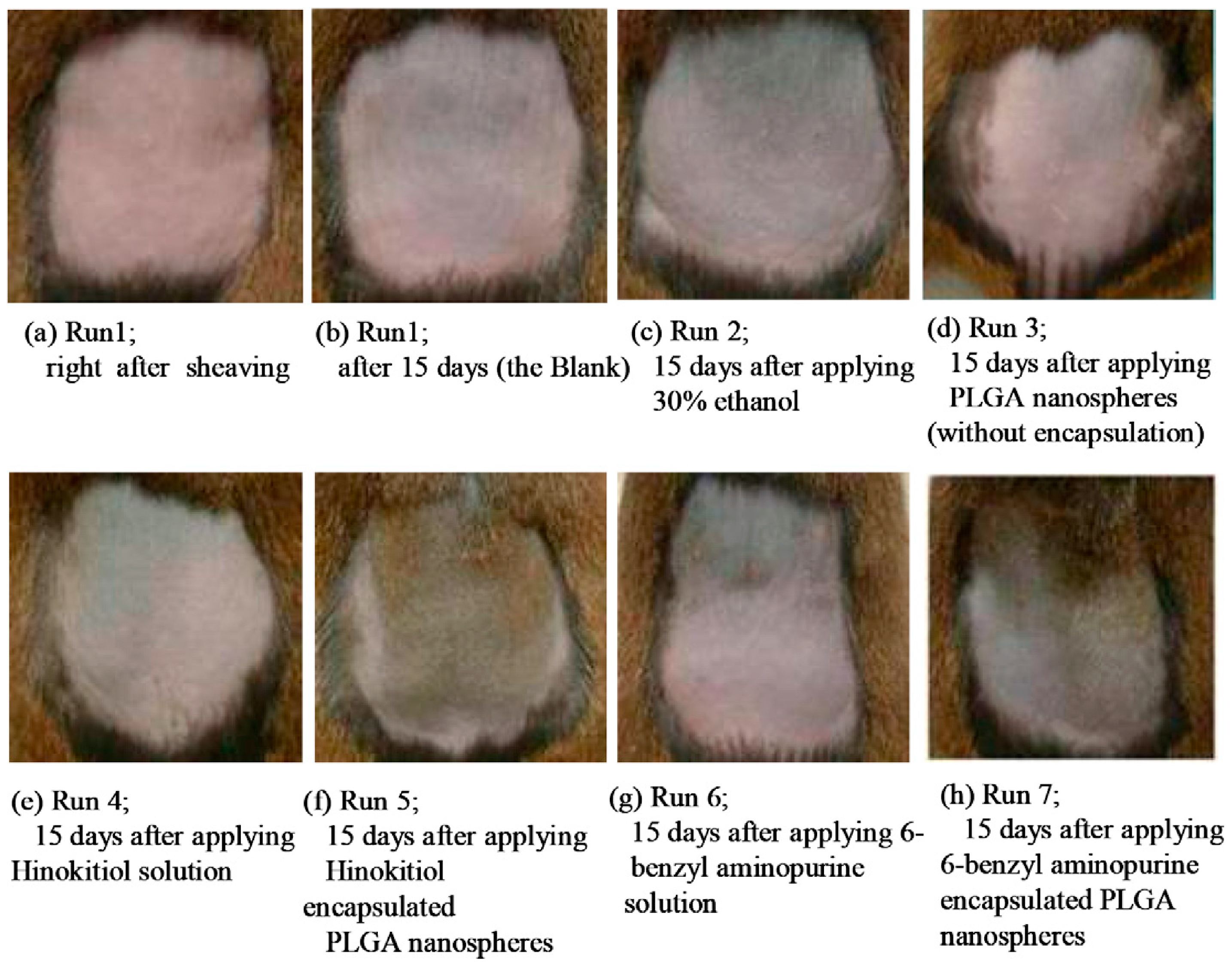Nanotechnology-Based Cosmetics for Hair Care
Abstract
:1. Introduction
2. Hair Anatomy
2.1. Hair Follicle

2.2. Hair Shaft
3. Follicular Targeting with Nanoparticles

4. Nanoparticles in Hair Cosmeceuticals
4.1. General Appearance

4.2. Hair Color

4.3. Hair Growth and Removal

5. Conclusion
Author Contributions
Conflicts of Interest
References
- Van der Donk, J.; Passchier, J.; Knegt-Junk, C.; van der Wegen-Keijser, M.H.; Nieboer, C.; Stolz, E.; Verhage, F. Psychological characteristics of women with androgenetic alopecia: A controlled study. Br. J. Dermatol. 1991, 125, 248–252. [Google Scholar] [CrossRef] [PubMed]
- Jelen, K.; Skřontová, M.; Simkova, L.; Zeman, J.; Tlapáková, E.; Fanta, O. Changes in the mechanical parameters of hair in a group of women in reproductive age. Neuroendocrinol. Lett. 2014, 35, 481–489. [Google Scholar] [PubMed]
- Haveli, S.D.; Walter, P.; Patriarche, G.; Ayache, J.; Castaing, J.; van Elslande, E.; Tsoucaris, G.; Wang, P.A.; Kagan, H.B. Hair fiber as a nanoreactor in controlled synthesis of fluorescent gold nanoparticles. Nano lett. 2012, 12, 6212–6217. [Google Scholar] [CrossRef] [PubMed]
- Alvarez-Román, R.; Naik, A.; Kalia, Y.N.; Guy, R.H.; Fessi, H. Skin penetration and distribution of polymeric nanoparticles. J. Control. Release 2004, 99, 53–62. [Google Scholar] [CrossRef] [PubMed]
- Souto, E.B.; Muller, R.H. Cosmetic features and applications of lipid nanoparticles (SLN, NLC). Int. J. Cosmet. Sci. 2008, 30, 157–165. [Google Scholar] [CrossRef] [PubMed]
- Schneider, M.R.; Paus, R. Deciphering the functions of the hair follicle infundibulum in skin physiology and disease. Cell Tissue Res. 2014, 358, 697–704. [Google Scholar] [CrossRef] [PubMed]
- Sanchez, L.A.; Perez, M.; Azziz, R. Laser hair reduction in the hirsute patient: A critical assessment. Hum. Reprod. Update 2002, 8, 169–181. [Google Scholar] [CrossRef] [PubMed]
- Contri, R.V.; Fiel, L.A.; Pohlmann, A.R.; Guterres, S.S.; Beck, R.C.R. Transport of substances and nanoparticles across the skin and in vitro models to evaluate skin permeation and/or penetration. In Nanocosmetics and Nanomedicines: New Approaches for Skin Care; Beck, R., Guterres, S., Pohlmann, A., Eds.; Springer: Berlin, Germany, 2011; pp. 3–35. [Google Scholar]
- Antonio, J.R.; Antonio, C.R.; Cardeal, I.L.S.; Ballavenuto, J.M.A.; Oliveira, J.R. Nanotechnology in dermatology. An. Bras. Dermatol. 2014, 89, 126–136. [Google Scholar] [CrossRef] [PubMed]
- Otberg, N.; Richter, H.; Schaefer, H.; Blume-Peytavi, U.; Sterry, W.; Lademann, J. Variations of hair follicle size and distribution in different body sites. J. Investig. Dermatol. 2004, 122, 14–19. [Google Scholar] [CrossRef] [PubMed]
- Vogt, A.; Mandt, N.; Lademann, J.; Schaefer, H.; Blume-Peytavi, U. Follicular targeting—A promising tool in selective dermatotherapy. J. Investig. Dermatol. Symp. Proc. 2005, 10, 252–255. [Google Scholar] [CrossRef] [PubMed]
- Tenjarla, S.N.; Kasina, R.; Puranajoti, P.; Omar, M.S.; Harris, W.T. Synthesis and evaluation of N-acetylprolinate esters—Novel skin penetration enhancers. Int. J. Pharm. 1999, 192, 147–158. [Google Scholar] [CrossRef]
- Rancan, F.; Afraz, Z.; Combadiere, B.; Blume-Peytavi, U.; Vogt, A. Hair follicle targeting with nanoparticles. In Nanotechnology in Dermatology; Springer: Berlin, Germany, 2013; pp. 95–107. [Google Scholar]
- Toll, R.; Jacobi, U.; Richter, H.; Lademann, J.; Schaefer, H.; Blume-Peytavi, U. Penetration profile of microspheres in follicular targeting of terminal hair follicles. J. Investig. Dermatol. 2004, 123, 168–176. [Google Scholar] [CrossRef] [PubMed]
- Vogt, A.; Combadiere, B.; Hadam, S.; Stieler, K.M.; Lademann, J.; Schaefer, H.; Autran, B.; Sterry, W.; Blume-Peytavi, U. 40 nm, but not 750 or 1,500 nm, nanoparticles enter epidermal CD1a+ cells after transcutaneous application on human skin. J. Investig. Dermatol. 2006, 126, 1316–1322. [Google Scholar] [CrossRef] [PubMed]
- Patzelt, A.; Richter, H.; Knorr, F.; Schäfer, U.; Lehr, C.-M.; Dähne, L.; Sterry, W.; Lademann, J. Selective follicular targeting by modification of the particle sizes. J. Control. Release 2011, 150, 45–48. [Google Scholar] [CrossRef] [PubMed]
- Lademann, J.; Patzelt, A.; Richter, H.; Antoniou, C.; Sterry, W.; Knorr, F. Determination of the cuticula thickness of human and porcine hairs and their potential influence on the penetration of nanoparticles into the hair follicles. J. Biomed. Opt. 2009, 14, 021014. [Google Scholar] [CrossRef] [PubMed]
- Lademann, J.; Richter, H.; Teichmann, A.; Otberg, N.; Blume-Peytavi, U.; Luengo, J.; Weiss, B.; Schaefer, U.F.; Lehr, C.M.; Wepf, R.; et al. Nanoparticles—An efficient carrier for drug delivery into the hair follicles. Eur. J. Pharm. Biopharm. 2007, 66, 159–164. [Google Scholar] [CrossRef] [PubMed]
- Lademann, J.; Weigmann, H.J.; Rickmeyer, C.; Barthelmes, H.; Schaefer, H.; Mueller, G.; Sterry, W. Penetration of titanium dioxide microparticles in a sunscreen formulation into the horny layer and the follicular orifice. Skin Pharmacol. Physiol. 1998, 12, 247–256. [Google Scholar] [CrossRef]
- Labouta, H.I.; Schneider, M. Interaction of inorganic nanoparticles with the skin barrier: Current status and critical review. Nanomedicine 2013, 9, 39–54. [Google Scholar] [CrossRef] [PubMed]
- Patzelt, A.; Lademann, J. Drug delivery to hair follicles. Expert Opin. Drug Deliv. 2013, 10, 787–797. [Google Scholar] [CrossRef] [PubMed]
- Huang, Y.; Yu, F.; Park, Y.-S.; Wang, J.; Shin, M.C.; Chung, H.S.; Yang, V.C. Co-administration of protein drugs with gold nanoparticles to enable percutaneous delivery. Biomaterials 2010, 31, 9086–9091. [Google Scholar] [CrossRef] [PubMed]
- Lademann, J.; Richter, H.; Meinke, M.; Sterry, W.; Patzelt, A. Which skin model is the most appropriate for the investigation of topically applied substances into the hair follicles? Skin Pharmacol. Physiol. 2010, 23, 47–52. [Google Scholar] [CrossRef] [PubMed]
- Patzelt, A.; Richter, H.; Buettemeyer, R.; Huber, H.J.; Blume-Peytavi, U.; Sterry, W.; Lademann, J. Differential stripping demonstrates a significant reduction of the hair follicle reservoir in vitro compared to in vivo. Eur. J. Pharm. Biopharm. 2008, 70, 234–238. [Google Scholar] [CrossRef] [PubMed]
- Hinsz, V.B.; Matz, D.C.; Patience, R.A. Does women's hair signal reproductive potential? J. Exp. Soc. Psychol. 2001, 37, 166–172. [Google Scholar] [CrossRef]
- Takahashi, T.; Imai, M.; Suzuki, I.; Sawai, J. Growth inhibitory effect on bacteria of chitosan membranes regulated with deacetylation degree. Biochem. Eng. J. 2008, 40, 485–491. [Google Scholar] [CrossRef]
- Lohani, A.; Verma, A.; Joshi, H.; Yadav, N.; Karki, N. Nanotechnology-based cosmeceuticals. ISRN Dermatol. 2014, 2014. [Google Scholar] [CrossRef] [PubMed]
- Gergely, A.; Coroyannakis, L. Nanotechnology in the EU cosmetics regulation. Househ. Pers. Care Today 2009, 3, 28–30. [Google Scholar]
- Hu, Z.; Liao, M.; Chen, Y.; Cai, Y.; Meng, L.; Liu, Y.; Lv, N.; Liu, Z.; Yuan, W. A novel preparation method for silicone oil nanoemulsions and its application for coating hair with silicone. Int. J. Nanomed. 2012, 7, 5719–5724. [Google Scholar]
- Pereda, M.D.C.V.; Polezel, M.A.; de Campos Dieamant, G.; Nogueira, C.; Marcelino, A.G.; Rossan, M.R.; Santana, M.H.A. Sericin Cationic Nanoparticles for Application in Products for Hair and Dyed Hair. Patent US20120164196 A1, 28 June 2012. [Google Scholar]
- Sonneville-Aubrun, O.; Simonnet, J.T.; L’Alloret, F. Nanoemulsions: A new vehicle for skincare products. Adv. Colloid Interface Sci. 2004, 108, 145–149. [Google Scholar] [CrossRef] [PubMed]
- Dickhof, S.; Franklin, J.; Busch, P.; Kropf, C.; Fischer, D. Cosmetic composition, for preventing greasy appearance on hair, contains nanoparticles of oxide, oxide-hydrate, hydroxide, carbonate, silicate or phosphate of calcium, magnesium, aluminum, titanium, zirconium or zinc. Patent DE19946784 A12001, 19 April 2001. [Google Scholar]
- Morganti, P.; Palombo, M.; Cardillo, A.; del Ciotto, P.; Morganti, G.; Gazzaniga, G. Anti-dandruff and anti-oily efficacy of hair formulations with a repairing and restructuring activity. The positive influence of the Zn-chitin nanofibrils complexes. J. Appl. Cosmet. 2012, 30, 149–159. [Google Scholar]
- Han, G.; Friedman, A.J.; Friedman, J.M. Nitric oxide releasing nanoparticle synthesis and characterization. In Nitric Oxide; Springer: Berlin, Germany, 2011; pp. 187–195. [Google Scholar]
- Morel, O.J.; Christie, R.M. Current trends in the chemistry of permanent hair dyeing. Chem. Rev. 2011, 111, 2537–2561. [Google Scholar] [CrossRef] [PubMed]
- Thun, M.J.; Altekruse, S.F.; Namboodiri, M.M.; Calle, E.E.; Myers, D.G.; Heath, C.W. Hair dye use and risk of fatal cancers in US women. J. Natl. Cancer Inst. 1994, 86, 210–215. [Google Scholar] [CrossRef] [PubMed]
- Lee, H.-Y.; Jeong, Y.-I.; Kim, D.-H.; Choi, K.-C. Permanent hair dye-incorporated hyaluronic acid nanoparticles. J. Microencapsul. 2013, 30, 189–197. [Google Scholar] [CrossRef] [PubMed]
- Sampaio, S.; Maia, F.; Gomes, J.R. Diffusion of coloured silica nanoparticles into human hair. Color. Technol. 2011, 127, 55–61. [Google Scholar] [CrossRef] [Green Version]
- Gourlaouen, L.; Lee, K. Composition and method of dyeing keratin fibers comprising luminescent semiconductive nanoparticles. Patent US20040253757 A1, 16 December 2004. [Google Scholar]
- Huang, X.; Kobos, R.K.; Xu, G. Hair coloring and cosmetic compositions comprising carbon nanotubes. Patent US7276088 B2, 2 October 2007. [Google Scholar]
- Hoffman, R.M. Topical liposome targeting of dyes, melanins, genes, and proteins selectively to hair follicles. J. Drug Target. 1998, 5, 67–74. [Google Scholar] [CrossRef] [PubMed]
- El-Domyati, M.; Attia, S.; Saleh, F.; Abdel-Wahab, H. Androgenetic alopecia in males: A histopathological and ultrastructural study. J. Cosmet. Dermatol. 2009, 8, 83–91. [Google Scholar] [CrossRef] [PubMed]
- Gomes, M.J.; Martins, S.; Ferreira, D.; Segundo, M.A.; Reis, S. Lipid nanoparticles for topical and transdermal application for alopecia treatment: Development, physicochemical characterization, and in vitro release and penetration studies. Int. J. Nanomed. 2014, 9, 1231–1242. [Google Scholar]
- Williamson, D.; Gonzalez, M.; Finlay, A.Y. The effect of hair loss on quality of life. J. Eur. Acad. Dermatol. Venereol. 2001, 15, 137–139. [Google Scholar] [CrossRef] [PubMed]
- Cash, T.F. The psychological effects of androgenetic alopecia in men. J. Am. Acad. Dermatol. 1992, 26, 926–931. [Google Scholar] [CrossRef]
- Zhou, Z.; Lenk, R.; Dellinger, A.; MacFarland, D.; Kumar, K.; Wilson, S.R.; Kepley, C.L. Fullerene nanomaterials potentiate hair growth. Nanomed. Nanotechnol. Biol. Med. 2009, 5, 202–207. [Google Scholar] [CrossRef] [PubMed]
- Padois, K.; Cantiéni, C.; Bertholle, V.; Bardel, C.; Pirot, F.; Falson, F. Solid lipid nanoparticles suspension versus commercial solutions for dermal delivery of minoxidil. Int. J. Pharm. 2011, 416, 300–304. [Google Scholar] [CrossRef] [PubMed]
- Madheswaran, T.; Baskaran, R.; Thapa, R.K.; Rhyu, J.Y.; Choi, H.Y.; Kim, J.O.; Yong, C.S.; Yoo, B.K. Design and in vitro evaluation of finasteride-loaded liquid crystalline nanoparticles for topical delivery. AAPS PharmSciTech 2013, 14, 45–52. [Google Scholar] [CrossRef] [PubMed]
- Tsujimoto, H.; Hara, K.; Tsukada, Y.; Huang, C.C.; Kawashima, Y.; Arakaki, M.; Okayasu, H.; Mimura, H.; Miwa, N. Evaluation of the permeability of hair growing ingredient encapsulated plga nanospheres to hair follicles and their hair growing effects. Bioorg. Med. Chem. Lett. 2007, 17, 4771–4777. [Google Scholar] [CrossRef] [PubMed]
- Hwang, S.L.; Kim, J.C. In vivo hair growth promotion effects of cosmetic preparations containing hinokitiol-loaded poly(epsilon-caprolacton) nanocapsules. J. Microencapsul. 2008, 25, 351–356. [Google Scholar] [CrossRef] [PubMed]
- Harris, T.J.; Kim, A.A.C. Hair removal with nanoparticles. Patent US8821941 B2, 2 September 2014. [Google Scholar]
© 2015 by the authors; licensee MDPI, Basel, Switzerland. This article is an open access article distributed under the terms and conditions of the Creative Commons Attribution license (http://creativecommons.org/licenses/by/4.0/).
Share and Cite
Rosen, J.; Landriscina, A.; Friedman, A.J. Nanotechnology-Based Cosmetics for Hair Care. Cosmetics 2015, 2, 211-224. https://doi.org/10.3390/cosmetics2030211
Rosen J, Landriscina A, Friedman AJ. Nanotechnology-Based Cosmetics for Hair Care. Cosmetics. 2015; 2(3):211-224. https://doi.org/10.3390/cosmetics2030211
Chicago/Turabian StyleRosen, Jamie, Angelo Landriscina, and Adam J. Friedman. 2015. "Nanotechnology-Based Cosmetics for Hair Care" Cosmetics 2, no. 3: 211-224. https://doi.org/10.3390/cosmetics2030211




